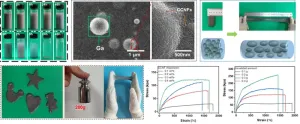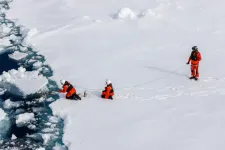(Press-News.org) The study was carried out in an animal model with oral administration of MNPs, in this case polystyrene, a widely-used plastic which is also found in food packaging. Led by Lukas Kenner (Department of Pathology at MedUni Vienna and Department of Laboratory Animal Pathology at Vetmeduni) and Oldamur Hollóczki (Department of Physical Chemistry, University of Debrecen, Hungary) the research team was able to determine that tiny polystyrene particles could be detected in the brain just two hours after ingestion. The mechanism that enabled them to breach the blood-brain barrier was previously unknown to medical science. "With the help of computer models, we discovered that a certain surface structure (biomolecular corona) was crucial in enabling plastic particles to pass into the brain," Oldamur Hollóczki explained.
Researching impact on health
The blood-brain barrier is an important cellular barrier that prevents pathogens or toxins from reaching the brain. The intestine has a similar protective wall (intestinal barrier), which can also be breached by MNPs, as various scientific studies have demonstrated. Intensive research is being conducted on the health effects of plastic particles in the body. MNPs in the gastrointestinal tract have already been linked with local inflammatory and immune reactions, and the development of cancer. "In the brain, plastic particles could increase the risk of inflammation, neurological disorders or even neurodegenerative diseases such as Alzheimer's or Parkinson's," said Lukas Kenner, pointing out that more research is needed in this area.
Restrict the use of MNPs
Nanoplastics are defined as having a size of less than 0.001 millimetres, while at 0.001 to 5 millimetres, some microplastics are still visible to the naked eye. MNPs enter the food chain through various sources including packaging waste. But it is not just solid food that plays a role, but liquids too: according to one study, anyone who drinks the recommended 1.5-2 litres of water per day from plastic bottles will end up ingesting around 90,000 plastic particles a year in the process. However, drinking tap water instead can – depending on the geographical location – help reduce this figure to 40,000. "To minimise the potential harm of micro- and nanoplastic particles to humans and the environment, it is crucial to limit exposure and restrict their use while further research is carried out into the effects of MNPs," Lukas Kenner explained. The newly discovered mechanism by which MNPs breach protective barriers in the body has the potential to advance research in this area decisively.
END
Tiny plastic particles also find their way into the brain
Mechanism for breaching the blood-brain barrier described for the first time
2023-04-21
ELSE PRESS RELEASES FROM THIS DATE:
On-demand preparation of organosilicon reagents
2023-04-21
National University of Singapore (NUS) scientists have demonstrated that stepwise customised functionalisation of multihydrosilanes to access fully substituted silicon compounds can be realised using neutral eosin Y, an inexpensive dye molecule.
The development of a unified catalytic platform for stepwise and programmable functionalisation of multihydrosilanes is highly challenging. However, having this platform will facilitate the rational design of organosilanes with predictable functions, in which bespoke silane molecules are required. Three specific requirements ...
Green living environment in early childhood does not protect against eczema
2023-04-21
According to a new Finnish study, greenness around the home in early childhood does not seem to protect children from atopic eczema. Instead, the proximity of coniferous, mixed forests and agricultural areas was associated with elevated risk of eczema. The effect was seen especially in children who were born in the spring.
“General greenness around the home did not protect children against eczema, which was contrary to our expectations and to the hypothesised allergy protective effect of nature contacts. Eczema is, however, only one of the allergic diseases in children, albeit generally the first to emerge,” says MD Minna Lukkarinen, a paediatric specialist from the ...
Finnish population-based study: Vulnerable groups were the least likely to uptake COVID-19 vaccination
2023-04-21
A large-scale registry study in Finland has identified several factors associated with uptake of the first dose of COVID-19 vaccination. In particular, persons with low or no labor income and persons with mental health or substance abuse issues were less likely to vaccinate.
The study, carried out in collaboration between the University of Helsinki and the Finnish Institute of Health and Welfare, tested the association of nearly 3000 health, demographic and socio-economic variables with the uptake of the first COVID-19 vaccination dose across the entire Finnish population.
This work, just published in the Nature Human Behavior, is the largest study ...
Best practices in new product development: what separates the Best from the Rest?
2023-04-21
No single one practice is sufficient for greater innovation performance, say the researchers, overviewing the results of the most recent PDMA's 2021 global survey. The Best companies, according to the results, are better at employing multiple types of innovation, but the spend more time on radical innovation, are oriented towards risk-taking, and employ long-term strategies. The results were drawn from responses from 651 companies in 37 countries, the most extensive PDMA survey so far.
“I believe, we should fundamentally look ...
New study: No evidence that shielding reduced COVID-19 infections in Wales
2023-04-21
A research team from Swansea University have been examining data from the year after the policy was introduced in March 2020, concluding that a “lack of clear impact on infection rates raises questions about the success of shielding.”
Shielding was introduced to protect those thought to be at highest risk of serious harm should they catch COVID-19, for example because of preconditions such as cancer or medications that they were taking. Key to protecting vulnerable people was to reduce their risk of contracting COVID-19.
The ...
The climate and biodiversity crises are not two separate things
2023-04-21
An unprecedented and continuing loss of biodiversity has been sparked by anthropogenic climate change together with the intensive use and destruction of natural ecosystems. However, since the public often views the climate crisis and the biodiversity crisis as two separate catastrophes, an international team of researchers including paleontologist Prof. Dr. Wolfgang Kiessling from Friedrich-Alexander-Universität Erlangen-Nürnberg (FAU) calls for adopting a new perspective: In their review study just released in the journal “Science”, they recommend protecting and restoring at least 30 percent of all ...
Highly sensitive and self-healing conductive hydrogels fabricated from cationic cellulose nanofiber-dispersed liquid metal for strain sensors
2023-04-21
This study is led by Dr. Wenxia Liu (State Key Laboratory of Biobased Materials and Green Papermaking, Qilu University of Technology, Shandong Academy of Science). To uniformly disperse LM into hydrogel, she conceived and designed using CCNFs rich in quaternary ammonium groups to encapsulate LM droplets through an approach of Pickering emulsion. “The strong electrostatic attraction and ion-dipole interaction between the quaternary ammonium groups of CCNFs and the hydroxyl groups on LM droplet surfaces were expected to prevent the LM droplets from aggregation and coalescence. The incorporation of CCNFs into hydrogel with the LM droplets was also expected to improve the mechanical ...
International team of physicists explore microscopic filament behavior
2023-04-21
Recently-published research from an international team of physicists reveals how the three-dimensional shape of rigid microscopic filaments determines their dynamics when suspended in water, and how control of that shape can be used to engineer solid-like behavior even when the suspension is more than 99% water.
The paper, “Bonded straight and helical flagellar filaments form ultra-low-density glasses,” was co-authored by Georgetown physics professors Peter Olmsted and Jeffrey Urbach and graduate student Matthew ...
Arctic ice algae heavily contaminated with microplastics
2023-04-21
The alga Melosira arctica, which grows under Arctic sea ice, contains ten times as many microplastic particles as the surrounding seawater. This concentration at the base of the food web poses a threat to creatures that feed on the algae at the sea surface. Clumps of dead algae also transport the plastic with its pollutants particularly quickly into the deep sea - and can thus explain the high microplastic concentrations in the sediment there. Researchers led by the Alfred Wegener Institute have now reported this in the journal Environmental Science and Technology.
It is a food lift for bottom-dwelling animals in the deep sea: the alga Melosira arctica grows ...
Newly sequenced hornet genomes could help explain invasion success
2023-04-21
The genomes of two hornet species, the European hornet and the Asian hornet (or yellow-legged hornet) have been sequenced for the first time by a team led by UCL (University College London) scientists.
By comparing these decoded genomes with that of the giant northern hornet, which has recently been sequenced by another team, the researchers have revealed clues suggesting why hornets have been so successful as invasive species across the globe.
Hornets are the largest of the social wasps; they play important ...
LAST 30 PRESS RELEASES:
Injectable breast ‘implant’ offers alternative to traditional surgeries
Neuroscientists devise formulas to measure multilingualism
New prostate cancer trial seeks to reduce toxicity without sacrificing efficacy
Geometry shapes life
A CRISPR screen reveals many previously unrecognized genes required for brain development and a new neurodevelopmental disorder
Hot flush treatment has anti-breast cancer activity, study finds
Securing AI systems against growing cybersecurity threats
Longest observation of an active solar region
Why nail-biting, procrastination and other self-sabotaging behaviors are rooted in survival instincts
Regional variations in mechanical properties of porcine leptomeninges
Artificial empathy in therapy and healthcare: advancements in interpersonal interaction technologies
Why some brains switch gears more efficiently than others
UVA’s Jundong Li wins ICDM’S 2025 Tao Li Award for data mining, machine learning
UVA’s low-power, high-performance computer power player Mircea Stan earns National Academy of Inventors fellowship
Not playing by the rules: USU researcher explores filamentous algae dynamics in rivers
Do our body clocks influence our risk of dementia?
Anthropologists offer new evidence of bipedalism in long-debated fossil discovery
Safer receipt paper from wood
Dosage-sensitive genes suggest no whole-genome duplications in ancestral angiosperm
First ancient human herpesvirus genomes document their deep history with humans
Why Some Bacteria Survive Antibiotics and How to Stop Them - New study reveals that bacteria can survive antibiotic treatment through two fundamentally different “shutdown modes”
UCLA study links scar healing to dangerous placenta condition
CHANGE-seq-BE finds off-target changes in the genome from base editors
The Journal of Nuclear Medicine Ahead-of-Print Tip Sheet: January 2, 2026
Delayed or absent first dose of measles, mumps, and rubella vaccination
Trends in US preterm birth rates by household income and race and ethnicity
Study identifies potential biomarker linked to progression and brain inflammation in multiple sclerosis
Many mothers in Norway do not show up for postnatal check-ups
Researchers want to find out why quick clay is so unstable
Superradiant spins show teamwork at the quantum scale
[Press-News.org] Tiny plastic particles also find their way into the brainMechanism for breaching the blood-brain barrier described for the first time



